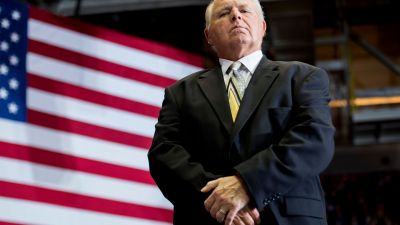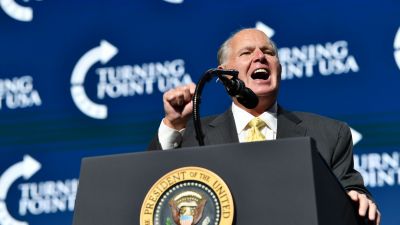
A new media ecology that has subtly transformed us in a way that reinforces the things we so lament in our politics today. (Photo by Frederic J. Brown/AFP/Getty Images)
When we talk about the media’s effect on our political discourse, usually we’re referring to the way politics are reported. There are, of course, lots of other ways in which media mediate the political process, from ads to organizing to community building to fundraising, all of which play major roles in our elections. Yet much larger than any of these may be the way the media alter our thinking about politics — purveying not just narratives that often decisively shape our opinions of a Trump or a Clinton or a Sanders, but also the larger psychological context in which we conceptualize our world and ourselves.
Over the past 30 years or so, the divisiveness, the paralysis, the seething anger, the very dissolution of politics as a mechanism for compromise and cooperation, have been the product of an energized right-wing cohort that confuses intransigence for principle. But they’re also the product of a new media ecology that has subtly transformed us in a way that reinforces the things we so lament in our politics today. It’s impossible to say whether the media introduced a new political predicate or reflected and intensified what was already brewing — probably a little of both.
Once, for all our differences, we lived in an American community that was in many ways bound by the media. Today, also in some measure because of the media, we don’t.
I am talking first and foremost about the internet and social media. Most of us know the clichés: Social media contribute to greater superficiality and less intellectual engagement, more impulsiveness, more opinion and less fact, and, perhaps most important, more polarization as the like-minded find one another and stoke one another’s prejudices and grievances, no matter what end of the political spectrum. It’s not that these things are not all true; there’s a good deal of evidence that they are. But there is something else under which they may be subsumed.
While the internet and social media have fueled polarization, the more accurate description might be “segmentation.” Oddly enough, segmentation was a long-standing media dream: that various pockets of America once forced to find commonality in the media could instead find niches. That dream was partly realized on radio, which was niche-programmed (top 40, easy listening, all-news), and then on cable TV, which began as a community “antenna” in underserved communities and quickly evolved into a series of niches — a food channel for foodies, a history channel for history buffs, sports channels for sports fans, etc.
But broadcast television was stuck in a stodgy old paradigm: the paradigm of the happy medium. It was forced to program for a vast common denominator, and that meant broadcast television news as well as entertainment shows.
There was a time, back in the late 1960s, when as many as half of the households in America that owned televisions tuned into the network evening news broadcasts every night — before aggressive talk radio and cable TV news, and long before the internet began peeling away audience. (On average, 24 million watch those broadcasts now — still sizable, but not enough to comprise a fund of national information.)
The ‘60s were a time of shared experiences and even of national conversations, since nearly everyone saw and heard the same things. It also was a time when network news divisions felt and evinced a deep responsibility to inform. After all, that was a primary reason why they had been given the airwaves — the public’s airwaves — in the first place. CBS head Williams S. Paley reassured his news staff, “I have Jack Benny to make money.”
It’s no accident that this occurred at a time when America had what historians have called the “American consensus” or the “liberal consensus,” or a sense of generally shared values. The media consensus and the political consensus, in fact, went hand in hand.
It is no accident either that the consensus began cracking at the very time right-wing talk radio and then cable news arrived — a crack to which the end of the Fairness Doctrine, requiring equal time for opposing views, certainly contributed. There were, of course, deep divisions before their arrival: geographical, racial, economic, even ideological, though I don’t remember the last ever being terribly pronounced, in part because we didn’t feel they were insurmountable. Republicans and Democrats saw things differently, sure. But they weren’t enemies in pitched battle. They were something else: opponents, as in the “loyal opposition.”
How long ago those days seem.
Talk radio and cable TV — which wasn’t using public airwaves and had no sense of public responsibility, only a sense of responsibility to shareholders — actively splintered us into audiences instead of uniting us into an audience. Prior to their ascendancy, though we had those old divisions we weren’t as fully aware of them, nor did we want to be. We preferred harmony to discord. But talk radio and cable made us aware. They worked at our wounds. They took disaffected individuals and forged them into an army. And it is that army, or rather, armies, that have declared war on American politics.
But all of this was comparatively benign until the internet, which is the grandest media “segmenter” ever devised. Talk radio and cable news had a few segments, basically right-wing and left-wing, and even the left was pretty thin, because while the right played to the idea of individualization and division, the left always favored community. The internet, however, has thousands of segments, thousands of pockets where individuals could find reinforcement of their feelings. The internet, and with it social media, knocked the American Humpty Dumpty off the wall, and it will never be put together again.
This is not the way adherents of the internet and social media put it. For them, Facebook, Twitter, Snapchat, Instagram and all the other apps are ways of connecting, not separating. If so, there seems to be very little evidence of it in our political life, other than those aggrieved clusters I mentioned finding one another. An article by Columbia professor Edward Mendelsohn in the current New York Review of Books, not about the internet and politics but about the internet and connectivity, makes a similar argument. On the one hand, Mendelsohn recognizes the ways in which the digital age has made life “increasingly public, open, external, immediate and exposed.” On the other hand, this exposure comes at the expense of our deepest, most permanent sense of self. Amid the churnings of the digital world with its constant updates, selfies, and news bits focusing on externalities, we are becoming unmoored from the larger world and from our more authentic selves. We are virtual selves, created for public export.
Mendelsohn quotes Virginia Heffernan’s new book, Magic and Loss: The Internet as Art, in which she says the digital connectedness that is so prevalent on social media is “illusory.” When we use social media, it usually seems less a way of connecting to others than of celebrating ourselves, less a dialogue with others than a monologue about us: what we’re eating, who we’re seeing, where we’re shopping, ad nauseam. Social media have helped create an America in which there is not only very little national conversation, common experience, sense of community or even very much desire to cross the boundaries that divide us; they have helped create an America of 300 million separate entities, each chronicling its own individual activities. You don’t have to imagine what this does to our politics. You’re living it.
Under these circumstances, a healthy political system cannot really exist. I am not sure healthy individuals can either. Heffernan goes on to say that in this digital age of non-stop communication, “we’re all more alone than ever.” That may be the most profound and enduring effect of the media on our politics. We are now so divided we may not be able to unite; we are so divided we live within an aching metaphysical malaise of unconnectedness. We have more “friends” than ever, but feel more friendless.
Ours is an extremely discontented country today, and a seemingly discontented world, too. We usually chalk it up to economic stress, inequality, globalization, disempowerment — the usual suspects. But that media-induced malaise that afflicts us, may be the anxiety of loneliness at a time when not only we have lost one another, we’ve lost our sense of self, the one anchor that might root us in the storm. We are adrift — some from the digital world and some within that world — and so are our politics.




